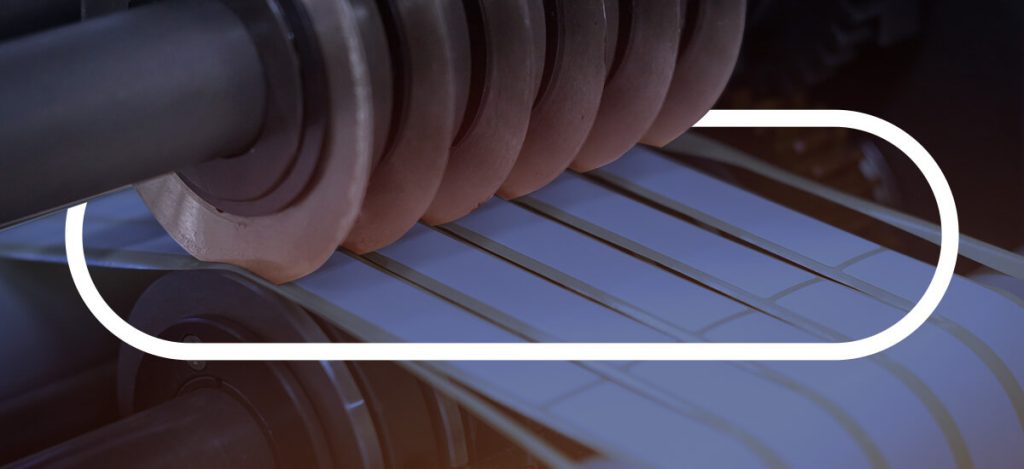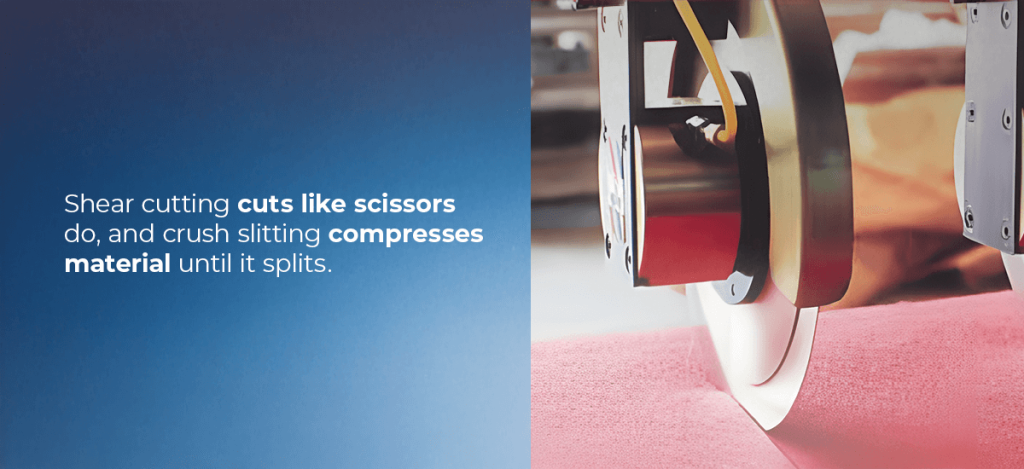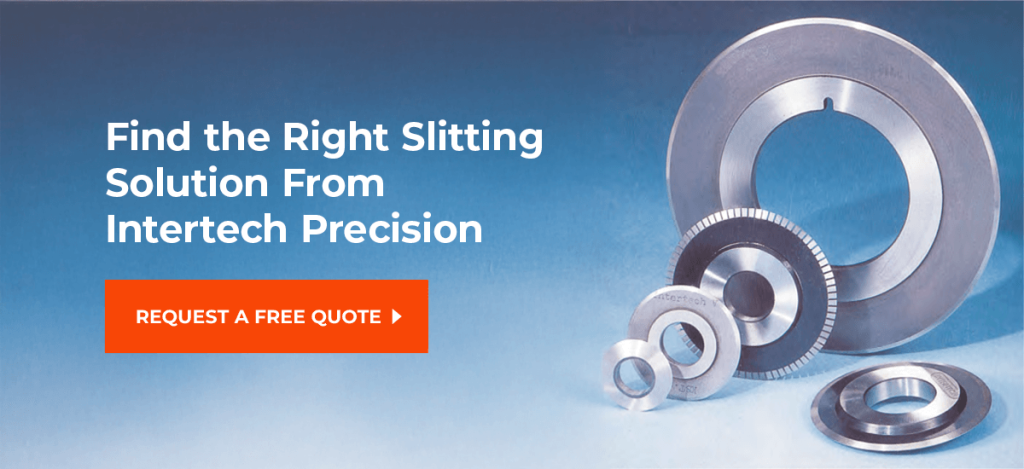
If you’re in an industry that deals with converting and slitting, you know the cutting method you choose directly impacts your output quality and bottom line. Packaging, textiles, electronics, and automotive applications all depend on slitting to cut materials into rolls or sheets.
Shear slitting and crush slitting are two common methods used by manufacturers. Let’s break down these techniques to help you find the best solution for your material and production goals.
What Is Shear Slitting?
Shear slitting uses two precisely aligned rotary knives that overlap slightly, creating a scissor-like cutting action. The equipment passes material between the blades, which cleanly slice through the material. Shear methods produce no tearing or crushing. This clean cut makes it ideal for applications demanding high levels of cut accuracy, edge quality, and dust reduction.
Advantages of shear slitting include:
- Low dust generation
- High-quality, burr-free cuts
- Consistent performance at high speeds
While shear cutting is an effective method, it does have some considerations. The equipment requires careful setup and consistent blade overlap. Improper blade alignment can lead to inconsistent cuts, increased dust, and premature blade wear. Shear cutting equipment is also more expensive to purchase, since facilities need precise holders and sharpening. Make sure to stay on top of maintenance to ensure longevity and effectiveness.
Shear Slitting Applications
Shear slitting is favored in industries requiring tight tolerances and high-speed production. Precision-driven environments like packaging, labeling and electronics are some industries that prefer shear methods. They use materials like:
- Paper
- Films
- Foils
- Laminates
- Pressure-sensitive adhesives
- Thin, layered materials
What Is Crush Slitting?
Crush or score slitting is a more straightforward cutting process. It uses a single rotary blade to press the material against an anvil roll. This process applies compressive force, tearing or fracturing the material. Instead of slicing like shear splitting, crush cutting breaks the material with pressure. It’s a good option for thicker, irregular or softer substrates.
Some of the biggest crushing advantages are:
- Lower equipment cost
- Simpler setup and operation
- Faster blade changes
- Minimal training to operate
Crush cutting delivers less expensive cutting results, but it has some limitations. The crushing process creates rougher edges and more dust, which can be problematic if you’re working on brittle or multi-layer materials. Crush slitters are also less precise than shear slitters, so keep wider tolerances.
Crush Slitting Applications
Textiles, converting, and packaging businesses all use crush cutting for their products. Slitting through tacky or soft layers can clog blades with material. Using crush slitting prevents this buildup and makes it easier to handle inconsistent materials. Some materials manufacturers use crushing on include:
- Rubber
- Insulation
- Non-wovens
- Fibrous materials
- Foams
What Is the Difference Between Shear and Crush Slitting?
The main difference between shear slitting and crush slitting is how each method separates material. Shear cutting cuts like scissors do, and crush slitting compresses material until it splits.
While shear and crush techniques are both types of slitting methods, they’re designed for different needs. Choosing the right method will dramatically impact product quality, line efficiency and blade life.

1. Edge Quality
Shear slitting delivers clean, precise edges with minimal deformation. Shear methods provide higher levels of accuracy as they cut with minimal dust. If appearances matter to your application, choose shear cutting. Crush slitting leaves rougher edges and more dust. Due to this residue, it’s less suited for cleanroom spaces or optical films.
2. Setup and Maintenance
Shear cutting systems have a much more involved setup. Since there are two rotary blades, these systems require precise alignment. Blades must overlap exactly to maintain cut quality. You’ll need experienced operators to get everything working correctly. Once it’s up and running, shear splitting systems must have routine maintenance like blade sharpening. A dull blade cannot perform to standard.
Crush slitting machines are much simpler to setup. They also need fewer blade maintenance sessions, reducing downtime. Keep an eye on the blades if you frequently work with abrasives. These materials will wear down blades faster.
3. Material Compatibility
Shear slitting excels with smooth, layered, and thin materials. It cuts through these materials easily without dragging or leaving ragged edges. Crush slitting handles thicker, softer materials more easily. Uneven, tacky, or abrasive materials often need crush cutting since they would get stuck in the shear slitter’s blades.
4. Equipment and Cost
Their more involved setup and equipment mean shear slitting systems are more expensive upfront. They have matched blade pairs, tighter tolerances, blade holders, and more frequent maintenance. All of these requirements increase overall costs. Crush systems have lower costs and are easier to scale with fewer adjustments.
5. Productivity and Speed
Shear slitting is well-suited for consistent, high-speed production runs. The dual-blade design means shear slitters quickly, cutting through material without sacrificing uniform results. Crush cutting offers fast changeovers and less operator interference. It can be more efficient for mixed-material lines or shorter production runs due to faster changeovers.
Considerations for Slitting
Finding the best system takes careful evaluation. It’s not just the materials you work with — it’s your operational goals and budget. Partnering with an experienced slitting partner can help engineers and facilities achieve the precise results they need to be successful. Make sure you’re breaking down these aspects of your operation to ensure you pick the best cutting method:
- Material variability: How wide is your material range? The more material types you process, the more flexibility you need. Choose crush slitters for wider material variability that doesn’t need precise knife overlap. Shear slitting is less forgiving when switching between materials.
- Run length: Longer production runs work best with shear slitters. They offer more consistency with longer cuts. Crush slitters are ideal for shorter runs and frequent changeovers.
- Maintenance capacity: How much maintenance downtime and costs can you afford? Shear cutting systems need more downtime and attention. Make sure your team can handle these demands.
Find the Right Slitting Solution From Intertech Precision
Whether you need high-speed precision for film or a blade designed to handle foams, Intertech Precision can help. We deliver slitting solutions engineered to your goals. We want slitting systems to work with your application. Off-the-shelf products are often one-size-fits-all. With unique throughputs, materials and production demands, you need systems designed for your needs.
With over 70 years of industry experience, Intertech Precision is your partner throughout the cutting process. We can evaluate your setup, recommend the ideal blade and holder, and get you a fast, accurate quote. We’re woman-owned and trusted by manufacturers like Tesla and Energizer. Reach out for your free quote today!

